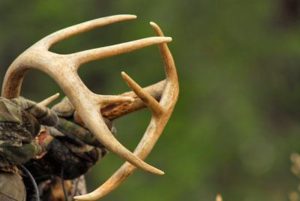 Trophy Deer rattling does work. There are a few things to consider, deer hunting tips, if you are going to try this proven, often very successful deer hunting strategy. First of all, you have to be in a hunting area that holds trophy deer. Also, the buck to doe ratio should be close to 50 – 50. Reason for this is the competition factor. If your hunting area is home to an over abundance of does, then a trophy deer may have no reason to investigate the sounds of fighting bucks or kick the butt of his competition. He has his pick of the litter, so to speak, and would rather be making love then fighting other trophy deer. This buck to do ratio is an important hunting tip, in your deer hunting management philosophy.
Trophy Deer rattling does work. There are a few things to consider, deer hunting tips, if you are going to try this proven, often very successful deer hunting strategy. First of all, you have to be in a hunting area that holds trophy deer. Also, the buck to doe ratio should be close to 50 – 50. Reason for this is the competition factor. If your hunting area is home to an over abundance of does, then a trophy deer may have no reason to investigate the sounds of fighting bucks or kick the butt of his competition. He has his pick of the litter, so to speak, and would rather be making love then fighting other trophy deer. This buck to do ratio is an important hunting tip, in your deer hunting management philosophy.
Contents
Quality Deer Management – Q.D.M.
Simply put, we need to harvest more does when deer hunting. Yes, there may be less deer initially. But the deer herd in your area will be stronger and more resilient as a result. All you have to do is look at the explosion in numbers of whitetail deer over the last three decades. When the next severe harsh winter sets in, and it will someday, we may lose a large percentage of our whitetail deer herd from starvation and possibly disease (and you say chronic wasting disease). There is only so much browse for them to eat in a long, cold, harsh winter. They can’t go down to the local whitetail deer supermarket, now can they? This is good reason to plant wildlife food plots as part of your Q.D.M. program; it will help nourish your local deer herd and help to carry them through distressed winters. Nature has a way of preserving the female species to procreate and survive. In a long, severe winter, with deep snow; where the amount of browse is finite, most young and old whitetail deer may starve to death. The trophy bucks; who after a long and hard rut of chasing multiple does, are just plain worn out. Under normal conditions, a dominate whitetail buck will breed between 3 and 5 does a breeding season. Remember; a dominate buck will tend a doe for days and stay with her until she succumbs to his wishes when she is at the peak of her estrus cycle. They become quite active, and food is one of the last things on a big bucks mind. Those who can’t replenish their fat stores before a harsh winter sets in may starve to death, or fall prey to predators as a result of their weakened state.
Trophy Whitetail Buck – Rattling Trophy Deer
If you are fortunate to live in hunting area where the buck to doe ratio is stable or close to that then here are some tips to remember, and practice.
First off, hunt the pre-rut. This is the time of the year when the bucks and trophy deer are establishing there dominance and territory. There will be light to medium sparring going on between bucks. They also use this time of sparring, along with rubbing saplings and small trees, to strengthen their neck muscles. This is a good time to try light rattling, not the full blown knock down type of deer fighting. Your rattling sequence should be softer than and not as long as later in the season when the rut is full blown.
Your Set Up
Some of the best times to rattle antlers for trophy deer are; early in the morning at first light, mid-day after they have been bedded a while and are ready to move about a little, and just before dusk when the deer are moving from bedding to feeding areas. Now, during the peak of the rut, rattling for trophy deer may work at anytime. The key here is to not be in an area that is hunted hard, or where the deer are pressured from other hunters. Especially hunters who have been rattling for deer themselves. Its best to set up so a trophy deer can’t approach you from downwind. Or if he was to, he would expose himself long before he was to get your scent. A portable stand on a field edge with the wind blowing into the field would be an example. You don’t want a nice buck sneaking up on you from behind through tick cover. Remember that‘s their M.O., so to speak. That’s why they’re a trophy deer and have survived.
Equipment For Rattling Trophy Deer
You may need quite a few items to rattle up a trophy deer. Besides a good stout set of trophy deer antlers, or a quality rattling bag, you will need a stand, or a blind (a make make-shift ground blind that matches your hunting area), deer calls, scents, binoculars, camouflage clothing, and other hunting gear (like a large buck decoy).
The Deer Rattling Sequence
These are great deer hunting tips. Practice these rattling deer hunting tips before you go into your deer hunting area. Start off with two short bleats/growls from your grunt call, do a light clashing of the antlers or the same with your rattling bag. Then do about 45 – 60 seconds of tickling them together. Fallowed by one parting grunt. Now wait and watch, about 5 minutes. Do this sequence again; just a little louder and about 30 seconds longer. Scrape the tree bark a little, and do some heavy breathing; like some puffing sounds with your mouth (imagine what a winded deer would sound like). Now wait about 20 minutes, watching and looking for any movement. A whitetail trophy deer may come charging in or just sneak in looking to see what’s going on in his territory. If no deer show up, do this same sequence again. When you do your calling; do directional grunting. Call in a 360 degree circle, you don’t want to sound stagnant or being froze in one spot. Muffle some of your grunt calls too. You want to sound as authentic as possible. Wait at least another 30 minutes or so before deciding to onto another location, or let your hunting area rest. One other hunting tip here is that if your deer hunting from the ground or in a hunting blind, don’t be afraid to make some noise on the ground. Shuffle your feet in the leaves or grass, even break some twigs – wouldn’t two trophy deer fighting? Just keep a sharp look-out.
Partner Up
A real good hunting tip and technique is to partner up with a deer hunting buddy when you are going to rattle for deer. As with all deer hunting tips, this one has to be planned out and executed properly. One deer hunter goes on stand or sets up in a blind. The other deer hunter, who will do the deer rattling, finds a concealed ground area within trees and brush, close by – 10 yards or so. Once both hunters are in place let things quiet down for 15 or 20 minutes. Now the deer hunter who is concealed starts the deer rattling sequence. Stomping/shuffling of feet on the ground, raking trees, breaking brush, snorting, heavy breathing, and short movements are necessary.
Peak Off The Rut Rattling
Basically you want to do the same as above, but louder and with more explosive vigor. Your first clash of the antlers should be forceful and loud. You want to sound like two huge trophy deer going at it; fighting for their lives. You want other trophy deer to be curious and come to the sounds of two trophy deer fighting. If using real antlers, be careful of your fingers. It is easy to smash a finger or two in the excitement. You may want to reverse the grip so the tines curve outward when you do your deer rattling sequence. It’s important to practice before you go out. There you go; give it a try and don’t be afraid to add your own techniques to your rattling sequence. Try using a decoy too. A trophy deer will expect to see another deer when he comes in to investigate. Put your decoy in a spot so that his attention is not looking in your direction, but away, or off to one side. Use good scent awareness; remember, you stink! Keep your movement to a minimum. Good luck and stay safe!


Reply